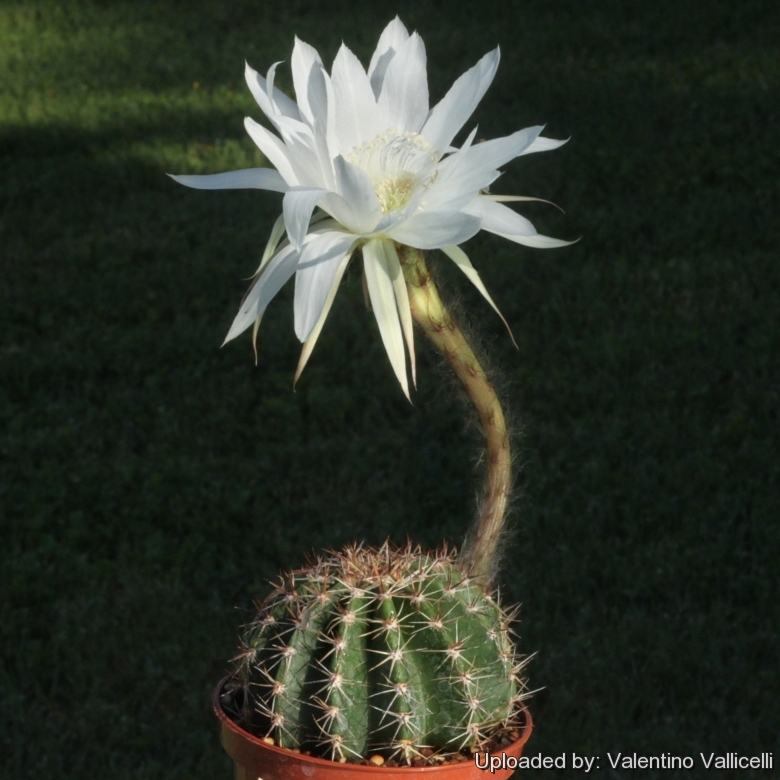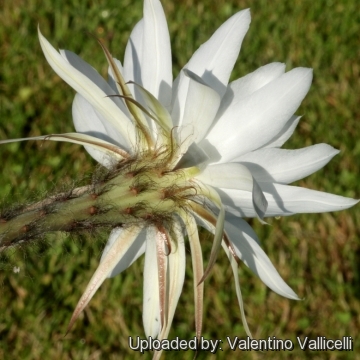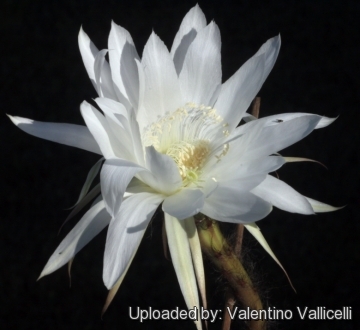
Echinopsis silvestrii Photo by: Valentino Vallicelli
Origin and Habitat: Echinopsis silvestriiSN|8696]]SN|8696]] is endemic to northwestern Argentina, where it occurs in Salta and Tucumán, it has a relatively small range (Extent of Occurrence estimated to be 6,000km2), it is severely fragmented, and the population is decreasing due to land use change.
Altitude range: It grows at elevations of 750 to 1,600 metres above sea level.
Habitat and Ecology: This cactus grows in thorn forest. It is locally abundant, but the population is decreasing. The species is affected by agro-industrial ranching and agriculture.
Synonyms:
Common Names include:
PERSIAN (فارسی): اکینوپسیس سیلوستری
Description: Echinopsis silvestrii is known for having gorgeous, white flowers at the ends of long tubes often as large or larger than the whole plant. The flower are scentless. It should not be confused with Echinopsis chamaecereusSN|8696]]SN|8692]], formerly known as Chamaecereus silvestriiSN|8694]]SN|8694]].
Habit: Plants mostly solitary, sometimes branching to form small clumps.
Stems: Globose to short cylindrical, 5-10 cm high, 4-8 cm in diameter.
Ribs: 12-14.
Areoles: Round, whitish.
Spines. Rather stout and short; greyish.
Central spine: Solitary, erect.
Radial spines: 5-9, flattened against the stem surface.
Flowers: White, not fragrant, to 20 cm long, inner perianth-segments obtuse, white; style white; stigma-lobes 9, white.
Note: Echinopsis silvestriiSN|8692]]SN|8696]] is poorly known and sometime synonymized with Echinopsis albispinosa K. Schumann 1903.
More...Bibliography: Major references and further lectures:
1) Edward Anderson “The Cactus family” Timber Press, Incorporated, 2001
2) James Cullen, Sabina G. Knees, H. Suzanne Cubey "The European Garden Flora Flowering Plants: A Manual for the Identification of Plants Cultivated in Europe, Both Out-of-Doors and Under Glass" Cambridge University Press, 11/Aug/2011
3) David R Hunt; Nigel P Taylor; Graham Charles; International Cactaceae Systematics Group. "The New Cactus Lexicon" dh books, 2006
4) N. L. Britton, J. N. Rose “The Cactaceae. Descriptions and Illustrations of Plants of the Cactus Family.” Volume 4, The Carnegie Institution of Washington, Washington 1923
5) Ortega-Baes, P., Lowry, M. & Kiesling, R. 2013. Echinopsis albispinosa. The IUCN Red List of Threatened Species. Version 2014.3. <www.iucnredlist.org>. Downloaded on 25 May 2015
6) Urs Eggli, Leonard E. Newton “Etymological Dictionary of Succulent Plant Names”. Springer, Berlin/Heidelberg 2010
More... Echinopsis silvestrii Photo by: Valentino Vallicelli
Echinopsis silvestrii Photo by: Valentino Vallicelli Echinopsis silvestrii Photo by: Valentino Vallicelli
Echinopsis silvestrii Photo by: Valentino Vallicelli Echinopsis silvestrii Photo by: Valentino Vallicelli
Echinopsis silvestrii Photo by: Valentino VallicelliSend a photo of this plant.The gallery now contains thousands of pictures, however it is possible to do even more. We are, of course, seeking photos of species not yet shown in the gallery but not only that, we are also looking for better pictures than those already present.
Read More... Cultivation and Propagation: Echinopsis silvestrii is extremely resistant to cultivation errors. The only thing that can kill this plant is cold. Nevertheless, it is appropriate to provide adequate growing conditions in order to obtain abundant blooms. It has very large fragrant nocturnal flowers and many plant lovers are willing to take care of it all year for one or a few magical nights with exotic charm.
Growth rate: It is a relatively rapidly growing species that will make large clumps given the best conditions.
Soils: It likes very porous standard cactus mix soil, but it is extremely adaptable to various growing media. Prefer a low pH compost, avoid substrata rich in limestone.
Repotting: This plant needs plenty of space for its roots, repotting should be done every other year or when the it has outgrown its pot. Use pot with good drainage.
Watering: Needs moderate to copious waterings in summer (it is more demanding than other cactus), but do not overwater, keep dry in winter at a minimum temperature of 0°C.
Fertilization: Feed with a high potassium fertilizer in summer.
Hardiness: Reputedly resistant to light frost if kept on the dry side prior to, and during, cold weather (hardy to -5 C ° C, or less for short periods). However warmth throughout the year will increase the grower's success (5°-8° C during rest season).
Exposition: The plant tolerates bright situations which encourages flowering and heavy spine production, but is likely to suffer from sun scorch or stunted growth if over exposed to direct sunlight during the hottest part of the day in summer. It grows well with filtered sunlight or afternoon shade.
Uses: It is an excellent plant for container growing. It look fine in a cold greenhouse and frame or outdoor in a rockery.
Pests & diseases: It may be attractive to a variety of insects, but plants in good condition should be nearly pest-free, particularly if they are grown in a mineral potting-mix, with good exposure and ventilation. Nonetheless, there are several pests to watch for:
- Red spiders: Red spiders may be effectively rubbed up by watering the plants from above.
- Mealy bugs: Mealy bugs occasionally develop aerial into the new growth among the wool with disfiguring results, but the worst types develop underground on the roots and are invisible except by their effects.
- Scales: Scales are rarely a problem.
- Rot: This species is particularly easy and accommodating, seldom suffer of cryptogamic diseases. Rot it is only a minor problem with Echinopsis if the plants are watered and “aired” correctly.
Propagation: Division of larger clumps, direct sow after last frost. Seeds germinate in 7-14 days at 21-27° C in spring, remove gradually the glass cover as soon the plants will be well rooted (ca 1-2 weeks) and keep ventilated, no full sun for young plants! To make a cutting twist off a branch and permit it to dry out a couple of weeks, lay it on the soil and insert the stem end partially into the soil. Try to keep the cutting somewhat upright so that the roots are able to grow downward.
More...













